


xxxxxIt was in 1848 that the Pre-Raphaelite Brotherhood (PRB) was founded as a secret society by three young English artists, Dante Gabriel Rossetti, John Everett Millais, and Holman Hunt. Its aim was to return to the artistic values of the Middle Ages, lost, it was argued, since the time of the great Renaissance painter Sanzio Raphael. There needed to be a return to serious subjects - mainly from literature and the bible - and the world had to be observed as it really was, not in idealized form. Initially the Brotherhood produced a number of attractive pictures, noted for their warmth of colour, their use of natural light, and their strict attention to detail. However, once the members of the PRB became known, their work came in for some severe criticism, mainly for their attack upon conventional art, and their realistic portrayal of sacred subjects. As a result, from then on Rossetti refused to exhibit his work in public, and Millais turned to producing paintings which found favour with the general public. By 1854 the movement had virtually collapsed, but it took on a new lease of life in 1861 when the artist William Morris founded a company to promote its ideals in the world of decorating and interior design. As we shall see, from 1870 (Vb) onwards this company proved highly successful both in Britain and on the Continent.
THE PRE-RAPHAELITE BROTHERHOOD (PRB) 1848 - 1854 (Va)
Acknowledgements
Rossetti: The Blue Closet – Tate Gallery, London; Self-Portrait – National Portrait Gallery, London; Girlhood of the Virgin Mary – Tate Gallery, London; Prosperine – Tate Gallery, London; The Annunciation – Tate Gallery, London; First anniversary of the death of Beatrice – Ashmolean Museum, Oxford; Passover with the Holy Family – Tate Gallery, London. Millais: Self-Portrait – National Portrait Gallery, London; Christ in the house of his parents – Tate Gallery, London; Orphelia – Tate Gallery, London; The Blind Girl – City Art Gallery, Birmingham, England; The Black Brunswicker – Lady Lever Art Gallery, Liverpool; Bubbles – Lady Lever Art Gallery, Liverpool. Effie Millais: detail, by the English portrait painter Thomas Richmond (1802-1874), 1851 – National Portrait Gallery, London. Hunt: Self-Portrait (detail) – Uffizi Gallery, Florence; The Light of the World – Keble College, Oxford; The Hireling Shepherd – City Art Gallery, Manchester; The Lady of Shalott – City Art Gallery, Manchester; Shadow of Death – City Art Gallery, Manchester. Hughes: Self-Portrait – National Portrait Gallery, London; The Guarded Bower – Gallery of Art, Bristol.
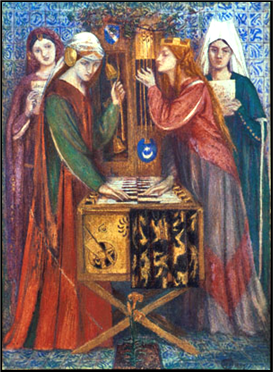 xxxxxThe Pre-Raphaelite Brotherhood (PRB), a secret society of young British artists, was formed in 1848 in protest against the trivial, idealistic style of painting which, it was argued, had dominated the artistic world since the works of the great Renaissance painter Sanzio Raphael. Its founding members, Dante Gabriel Rossetti, John Everett Millais and Holman Hunt - all students at the Royal Academy - aimed to return to the artistic values of the Middle Ages by concentrating on serious subjects - mainly from literature and the bible - and by observing the world as it really was, in accordance with John Ruskin’s doctrine of “truth to nature”.
xxxxxThe Pre-Raphaelite Brotherhood (PRB), a secret society of young British artists, was formed in 1848 in protest against the trivial, idealistic style of painting which, it was argued, had dominated the artistic world since the works of the great Renaissance painter Sanzio Raphael. Its founding members, Dante Gabriel Rossetti, John Everett Millais and Holman Hunt - all students at the Royal Academy - aimed to return to the artistic values of the Middle Ages by concentrating on serious subjects - mainly from literature and the bible - and by observing the world as it really was, in accordance with John Ruskin’s doctrine of “truth to nature”.
xxxxxInitially, the Brotherhood produced a number of attractive pictures, noted technically for the warmth and glow of their colours, their use of natural light, and their strict attention to detail. The painting shown here, The Blue Closet, is a typical work by Rossetti. These were widely admired for their simple realism and their lofty moral tone, and the school attracted a number of disciples. However, as far as painting was concerned, the movement was of limited appeal and proved short lived. Some of the works by the founder members did not live up to their declared aims, and by turning its back on a tradition of painting going back three hundred years, the movement came in for some savage criticism once the meaning of the initials “PRB” had leaked out. Following the first issue of the Brotherhood’s journal The Germ in January 1850, its members were accused of insulting one of the world’s greatest artists - not to mention those who followed him - and of depicting venerated biblical figures as if they were ordinary people. Millais’ first paintings received scathing reviews, and such was the abuse hurled at one of Rossetti’s works, The Girlhood of Mary Virgin of 1849, that he vowed never to exhibit in public again. By 1851, despite Ruskin’s support for the brotherhood, the movement was beginning to break up, and it fell apart at the seams in 1853 when Millais joined the establishment - the enemy - by being elected an Associate of the Royal Academy. That, together with Hunt’s departure for the Holy Land the following year, brought an end to the “Round Table”, as Rossetti put it.
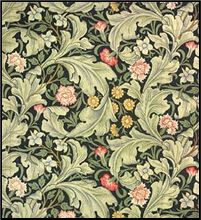 xxxxxBut the end of the Pre-Raphaelite Brotherhood by no means meant an end to its traditional art. Its former members continued to produce a number of paintings with a medieval flavour, full of colour and detail, and in 1857 Rossetti, encouraged by Ruskin, carried this art form into a new dimension, the world of decoration and interior design. In 1861 this led to the formation of a company by the artist and designer William Morris, assisted, amongst others, by the English painters Ford Madox Brown and Edward Burne Jones. As we shall see, from 1870 (Vb) onwards this company, aiming to revive individual craftsmanship in both handicraft and the arts of design, proved highly successful both in Britain and on the European continent, perpetuating thereby the vibrant colours and elaborate heraldic patterns of the Pre-Raphaelite movement.
xxxxxBut the end of the Pre-Raphaelite Brotherhood by no means meant an end to its traditional art. Its former members continued to produce a number of paintings with a medieval flavour, full of colour and detail, and in 1857 Rossetti, encouraged by Ruskin, carried this art form into a new dimension, the world of decoration and interior design. In 1861 this led to the formation of a company by the artist and designer William Morris, assisted, amongst others, by the English painters Ford Madox Brown and Edward Burne Jones. As we shall see, from 1870 (Vb) onwards this company, aiming to revive individual craftsmanship in both handicraft and the arts of design, proved highly successful both in Britain and on the European continent, perpetuating thereby the vibrant colours and elaborate heraldic patterns of the Pre-Raphaelite movement.
xxxxxIncidentally, one of the Brotherhood’s fiercest critics was the novelist Charles Dickens. He did not mince his words, describing their work as “odious, repulsive and revolting”. ……
xxxxx…… Rossetti insisted that, as a secret society, the brotherhood needed to have seven members. As a result four others were enlisted: a young sculptor named Thomas Woolner, a young painter named James Collinson, Rossitti’s brother William Michael, and Frederick Stephens, a friend of Holman Hunt. ……
xxxxx…… Axsimilar brotherhood to that of the Pre-Raphaelites was formed by a number of young German painters in 1809. Known as the Lucas Brotherhood or the Nazarines, they believed that, as in medieval times, all art should have a religious or moral value. They worked in Rome as from 1810, where they revived the medieval art of fresco painting. Their work was not particularly impressive, however, and the group had broken up by the late 1820s. ……
xxxxx…… ThexScottish artist William Dyce (1806-1864) met the Nazarines during visits to Italy in the 1820s, and some of his work, such as The Woman of Samaria (c1860), anticipated that of the Pre-Raphaelites. His final and outstanding work was a series of Arthurian frescoes in the robing room of the House of Lords, Westminster.
Including:
Dante Gabriel Rossetti,
John Everett Millais,
and Holman Hunt

Va-1837-1861-Va-1837-1861-Va-1837-1861-Va-1837-1861-Va-1837-1861-Va-1837-1861-Va
xxxxxThe English painter and poet Dante Gabriel Rossetti (1828-1882), one of the founder members of the Pre-Raphaelite Brotherhood, exemplified the aims of the movement in 1849 and 1850 with his two devout works, The Girlhood of Mary Virgin and The Annunciation. Such was the criticism that they aroused however, that whilst he continued to produce works in the same vein, he refused to show them in public. Notable amongst these were the water-colours The Anniversary of the Death of Beatrice of 1853 - full of warmth and tenderness - and paintings in a romantic medieval setting like The Blue Closet of 1857. An admirer of feminine beauty, he spent most of his last twenty years painting a series of attractive, sensuous women, such as the femme fatale entitled Astarte Syriaca, and the beautiful Proserpine. This series had little to do with the aims of the Pre-Raphaelites, but, as we shall see, in 1861 he supported the artist William Morris when he founded an interior design company based largely on the movement’s ideals, and he later made a contribution to the company’s success by his work in stained glass. As a poet he is remembered especially for The Blessed Damozel, My Sister’s Sleep, Love’s Nocturne, Sister Helen and The Burden of Nineveh, considered by many as his masterpiece.
xxxxxIn his day, Rossetti was indeed a poet of distinction, and his art work was often inspired by or related to the rich, imaginative verse he composed. His early poems were well received, but in 1862 when his beloved wife Lizzie died, he placed the manuscripts of all his poems in her coffin, and it was not until seven years later that he was persuaded to have them exhumed. They were published in 1870, and contained some of his finest work, including The Blessed Damozel, My Sister’s Sleep, Love’s Nocturne, Sister Helen and The Burden of Nineveh, considered by many as his masterpiece. In 1880 appeared his second volume of Ballads and Sonnets, notable above all for Rose Mary, The White Ship, and The House of Life, a collection of 101 sonnets on the theme of love. And during his literary career he translated Dante, and published The Early Italian Poets in 1861. His letters were published in 1895.
xxxxxApart from his many friends associated with the Brotherhood - notably Ford Madox Brown, John Ruskin and William Morris - Rossetti numbered among his acquaintances the writer Lewis Carroll, the poet Algernon Charles Swinburne, and the American painter James McNeill Whistler.
xxxxxIncidentally, his sister was the poetess Christina Rossetti, famous above all for her religious poetry and the poems she composed for children.
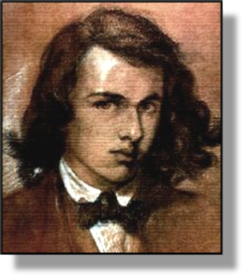 xxxxxThe English painter and poet Dante Gabriel Rossetti (1828-1882), the driving force in the founding of the Pre-Raphaelite Brotherhood (PRB), was born in London in 1828. His father, a poet and scholar, was an Italian exile, and his mother was half Italian, but, in fact, he never visited Italy and, apart from some short trips abroad, lived his life in London. There he attended art college, studied at the Royal Academy, and, for a short time, was apprenticed to the English painter Ford Madox Brown. Throughout his training, however, he disliked and rebelled against the traditional, academic methods of teaching, and he showed nothing but disdain for the art establishment. This is a self-portrait, painted in 1847.
xxxxxThe English painter and poet Dante Gabriel Rossetti (1828-1882), the driving force in the founding of the Pre-Raphaelite Brotherhood (PRB), was born in London in 1828. His father, a poet and scholar, was an Italian exile, and his mother was half Italian, but, in fact, he never visited Italy and, apart from some short trips abroad, lived his life in London. There he attended art college, studied at the Royal Academy, and, for a short time, was apprenticed to the English painter Ford Madox Brown. Throughout his training, however, he disliked and rebelled against the traditional, academic methods of teaching, and he showed nothing but disdain for the art establishment. This is a self-portrait, painted in 1847.
xxxxxHis decision to follow an artistic rather than a literary career was due to the friendship he struck up with two of his fellow students at the Royal Academy, John Everett Millais and Holman Hunt. With their support he conceived the idea of forming a secret society aimed at revitalising an art world which, in his view (and theirs) had been in decline since the days of the Renaissance artist Sanzio Raphael. There was a need to return to serious, meaningful subjects, and to portray them as true to life, not in artificial, idealised form. Rossetti’s first two oils, devout works entitled The Girlhood of Mary Virgin in 1849, and The Annunciation, a year later (both illustrated below), achieved this aim. Despite some technical flaws, they captured the sincerity, freshness and simplicity of medieval art.
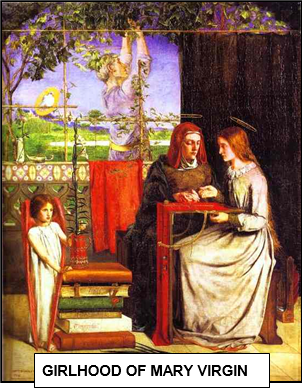 xxxxxHowever, once the meaning of the initials PRB had become general knowledge, the storm of criticism these works aroused upset and angered the young Rossetti. He continued to produce works in the same vein, but refused to exhibit them in public. These included The First Anniversary of the Death of Beatrice in 1853 and The Preparation for the Passover in the Holy Family of 1856 - watercolours full of warmth and tenderness (both illustrated below), as well as paintings in a romantic medieval setting, rich in colour and heraldic patterns, such as The Blue Closet, and The Wedding of St. George and the Princess Sabra, both produced in 1857. In these water colours, many inspired by Malory’s Morte D’Arthur or Tennyson’s Idylls of the King, he employed his own, highly original technique, laying on dry pigment in much the same way as one would use oils, and scratching the surface of the paint to provide texture.
xxxxxHowever, once the meaning of the initials PRB had become general knowledge, the storm of criticism these works aroused upset and angered the young Rossetti. He continued to produce works in the same vein, but refused to exhibit them in public. These included The First Anniversary of the Death of Beatrice in 1853 and The Preparation for the Passover in the Holy Family of 1856 - watercolours full of warmth and tenderness (both illustrated below), as well as paintings in a romantic medieval setting, rich in colour and heraldic patterns, such as The Blue Closet, and The Wedding of St. George and the Princess Sabra, both produced in 1857. In these water colours, many inspired by Malory’s Morte D’Arthur or Tennyson’s Idylls of the King, he employed his own, highly original technique, laying on dry pigment in much the same way as one would use oils, and scratching the surface of the paint to provide texture.
xxxxxA handsome, charming young man with a great deal of poise and personal magnetism, Rossetti was never without lady friends, be they, as he put it, “angels or whores”. One of his angels was the beautiful redhead called “Lizzie” Siddal, whom he married in 1860, and, on her death two years later, he worshipped the lovely Janey, wife of his friend William Morris. In the meantime he also enjoyed the company of lesser mortals, including the buxom Fanny Cornforth and the voluptuous Alexa Wilding.
xxxxxThese “stunners” often provided the inspiration as was well as the models both for the serious, devout works of his early days, and for his portraits of attractive, sensuous women, produced in large numbers during the last twenty years of his life. An ardent lover of female beauty, this series of languid female figures, ranging from the spiritual and majestic to the sumptuous and erotic, enhanced his reputation and increased his bank balance. Outstanding among this gallery of feminine beauty was his Beata Beatrix, a moving memorial to his wife Lizzie, Monna Vanna, a rich, lavish portrait of Alexa Wilding, Astarte Syriaca, a femme fatale who embodied “love’s all-penetrating spell”, and Proserpine, a portrait of stunning beauty modelled by Jane Morris (illustrated below), with whom he later had an affair.
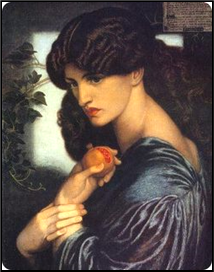
xxxxxThese later works, though highly attractive, had little to do with the strict ideals of the Pre-Raphaelite movement. However, in the late 1850s his meeting with the artists William Morris and Edward Burne-Jones took the movement in a new and unexpected direction. It was while they were attempting to produce Arthurian frescoes for the Oxford Union that they became interested in the revival of individual handicraft in the field of decorative design. Encouraged by Ruskin and Rossetti, in 1861 Morris founded a company which, as we shall see, was to take Pre-Raphaelite art into the world of decoration and interior design. Here, Rossetti was to make an important contribution in the revival of stained glass windows.
xxxxxIn 1872 he had a break down in health, due in no small part to heavy drinking and the taking of drugs to combat insomnia. He recovered to some degree, but he spent the last ten years of his life as an eccentric recluse in Chelsea, his house full of antiques, and a menagerie of exotic animals in the garden. In December 1881 he suffered a severe stroke and died the following year while convalescing near Margate on the Kent coast. His tombstone at Birchington-on-Sea, designed by Ford Madox Brown, records that he was “honoured among painters as a painter, and among poets as a poet”.
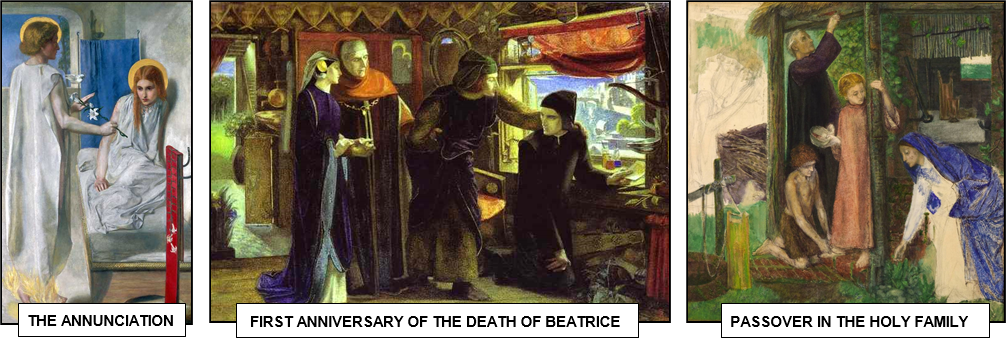
xxxxxThe English artist John Everett Millais (1829-1896) was the most talented of the Pre-Raphaelite Brotherhood. His early work, Christ in the House of his Parents, exhibited in 1850, came in for some scathing criticism, condemned for its realistic portrayal of a sacred subject, but for a time he continued to produce works which were serious in subject matter, rich in colour, and true to nature. These included Marian of 1851, his magnificent Ophelia, the following year, and his The Blind Girl and Autumn Leaves of 1856. By then, however, Millais had brought about the collapse of the Brotherhood by becoming an Associate member of the Royal Academy - an act of treachery in the eyes of Rossetti. Furthermore, following highly popular works like The Order of Release and The Black Brunswicker, he turned to producing high quality money-spinners, such as The Princes in the Tower, The Boyhood of Raleigh, and some charming studies of children, such as Cherry Ripe and his famous Bubbles. Engravings and colour prints of these works, plus portraits of the rich and famous - including those of Tennyson, Cardinal Newman, Gladstone and Disraeli - made him a wealthy and influential man. He was created a baronet in 1885, and elected President of the Royal Academy in the year of his death. He was a life-long friend of the artist Holman Hunt, and was on very close terms with John Ruskin until he fell in love with his wife Effie in 1853 and married her after her own marriage had been annulled. The scandal of this affair somewhat clouded his private life, happy though his marriage proved to be.
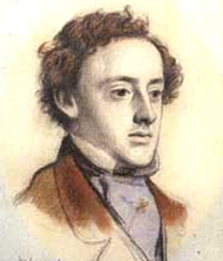 xxxxxAs a founder member of the Pre-Raphaelite Brotherhood, John Everett Millais (1829-1896) showed great promise in the opening years of the movement. His Lorenzo and Isabella, based on a poem by Keats and exhibited in 1849, together with his Christ in the House of his Parents, produced the following year, were serious in intent, rich in colour, and true to nature in every precise detail. The latter painting came in for some scathing criticism, condemned for its candid rendering of a sacred subject, but, supported by family and friends - including the formidable art critic John Ruskin - he continued to produce more works in the Pre-Raphaelite style. These included Mariana in 1851, based on a poem from Tennyson, his magnificent Ophelia of 1852, a painting of rare beauty and precision, and The Blind Girl and Autumn Leaves, thought-provoking works of 1856. These proved quite popular, but his next work of 1857, Sir Isumbras at the Ford, an Arthurian piece, was roundly denounced by the critics, and even dismissed as a “catastrophe” by Ruskin himself.
xxxxxAs a founder member of the Pre-Raphaelite Brotherhood, John Everett Millais (1829-1896) showed great promise in the opening years of the movement. His Lorenzo and Isabella, based on a poem by Keats and exhibited in 1849, together with his Christ in the House of his Parents, produced the following year, were serious in intent, rich in colour, and true to nature in every precise detail. The latter painting came in for some scathing criticism, condemned for its candid rendering of a sacred subject, but, supported by family and friends - including the formidable art critic John Ruskin - he continued to produce more works in the Pre-Raphaelite style. These included Mariana in 1851, based on a poem from Tennyson, his magnificent Ophelia of 1852, a painting of rare beauty and precision, and The Blind Girl and Autumn Leaves, thought-provoking works of 1856. These proved quite popular, but his next work of 1857, Sir Isumbras at the Ford, an Arthurian piece, was roundly denounced by the critics, and even dismissed as a “catastrophe” by Ruskin himself.

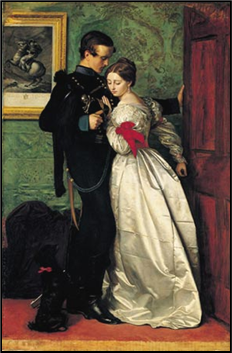 xxxxxBy then, however, Millais had brought about the virtual collapse of the brotherhood. A child of precocious artistic talent, and a star at the Royal Academy at the age of eleven, he began to see his future in commercial terms. In 1853 his The Order of Release, a highly romantic painting showing the release of a Jacobite rebel after the Battle of Culloden in 1746, proved extremely popular and earned him election as an Associate of the Royal Academy. (As far as Rossetti was concerned, this was joining the enemy and meant an end to the society). And the enormous success Millet achieved with his The Black Brunswicker of 1860, showing a soldier leaving his beloved on the eve of the Battle of Waterloo (illustrated right), convinced him that his future lay in pandering to the Victorian taste for the patriotic, the romantic, and the melodramatic. By the mid-1860s he had cast aside his role as a rebel and had become a respectable, accepted figure of the art establishment.
xxxxxBy then, however, Millais had brought about the virtual collapse of the brotherhood. A child of precocious artistic talent, and a star at the Royal Academy at the age of eleven, he began to see his future in commercial terms. In 1853 his The Order of Release, a highly romantic painting showing the release of a Jacobite rebel after the Battle of Culloden in 1746, proved extremely popular and earned him election as an Associate of the Royal Academy. (As far as Rossetti was concerned, this was joining the enemy and meant an end to the society). And the enormous success Millet achieved with his The Black Brunswicker of 1860, showing a soldier leaving his beloved on the eve of the Battle of Waterloo (illustrated right), convinced him that his future lay in pandering to the Victorian taste for the patriotic, the romantic, and the melodramatic. By the mid-1860s he had cast aside his role as a rebel and had become a respectable, accepted figure of the art establishment.
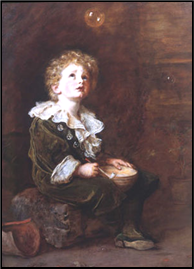 xxxxxIt was a change of direction that was to make Millet one of the most popular and richest artists of his day. Over the next thirty years he produced a steady stream of pot-boilers to delight an ever appreciative public. These included the dramatic The Princes in the Tower, the rousing The Boyhood of Raleigh, the delightful child portraits Cherry Ripe and Little Miss Muffet, and his most famous “chocolate box” picture of all, Bubbles (illustrated left), a charming portrait of his grandson which became known nationwide when it was made into an advertisement for Pears soap. Engravings and colour prints of such works were sold in vast numbers, and added to his fame and fortune. In the meantime, he produced numerous portraits of society ladies and eminent men of his day, including the churchman Cardinal Newman, the poet Tennyson, the politicians Disraeli and Gladstone, and the composer Arthur Sullivan. And he became noted too for his book illustrations following the success of his pen and ink drawings for the so-called Moxon edition of Tennyson’s poems in 1857.
xxxxxIt was a change of direction that was to make Millet one of the most popular and richest artists of his day. Over the next thirty years he produced a steady stream of pot-boilers to delight an ever appreciative public. These included the dramatic The Princes in the Tower, the rousing The Boyhood of Raleigh, the delightful child portraits Cherry Ripe and Little Miss Muffet, and his most famous “chocolate box” picture of all, Bubbles (illustrated left), a charming portrait of his grandson which became known nationwide when it was made into an advertisement for Pears soap. Engravings and colour prints of such works were sold in vast numbers, and added to his fame and fortune. In the meantime, he produced numerous portraits of society ladies and eminent men of his day, including the churchman Cardinal Newman, the poet Tennyson, the politicians Disraeli and Gladstone, and the composer Arthur Sullivan. And he became noted too for his book illustrations following the success of his pen and ink drawings for the so-called Moxon edition of Tennyson’s poems in 1857.
xxxxxSuch was the wealth he accumulated that in 1878 he moved his family to a palatial mansion in Kensington, complete with a large studio, and three years later rented a hunting lodge in Perthshire, where he could enjoy country sports and paint the wild Scottish scenery. In 1885 he was created a baronet, the first artist to be so honoured, and in 1896 he was elected President of the Royal Academy, just a few months before his death from throat cancer. At the request of the Academy, he was buried in St. Paul’s Cathedral following a service of great pomp and ceremony.
xxxxxBut whilst his artistic career was highly successful, his private life was clouded by scandal for many years, the result of his close friendship with John Ruskin. They first met in 1851 and two years later Millais joined Ruskin and his attractive wife Effie (Euphemia Gray) on a holiday in Scotland. By the end of their four-month stay at Brig o’Turk in the Trossachs, Millais and Effie had fallen deeply in love. In April 1854 Effie left Ruskin and sought an annulment on the ground that the marriage had never been consummated. The hearing, full of painful details, was the talk of the town, and people from all walks of life took sides in this tragic love triangle.
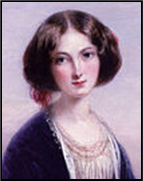 xxxxxFollowing the annulment, Millais and Effie were married in 1855, and the first of their eight children was born the following year. But throughout their married life Effie was shunned by many members of society. Queen Victoria, who openly admired Millet’s work, was shocked by what she saw as a sordid affair, and refused to receive Effie. It was not until Millet lay on his death bed that she granted his dying wish and met Effie privately at Windsor Castle. Effie herself died in December the following year. (Detail of portrait by the English artist Thomas Richmond.)
xxxxxFollowing the annulment, Millais and Effie were married in 1855, and the first of their eight children was born the following year. But throughout their married life Effie was shunned by many members of society. Queen Victoria, who openly admired Millet’s work, was shocked by what she saw as a sordid affair, and refused to receive Effie. It was not until Millet lay on his death bed that she granted his dying wish and met Effie privately at Windsor Castle. Effie herself died in December the following year. (Detail of portrait by the English artist Thomas Richmond.)
xxxxxDuring his lifetime and long since, Millet has often been accused of deserting the high ideals of the Pre-Raphaelite movement, and wasting his talent by pandering to public taste. It must be said in his defence, however, that the aims of the Brotherhood were restrictive, their works were limited in their appeal, and they brought little financial reward. Millet needed the money to support a large family. Furthermore, these later works - money-spinners though they were - were fully in keeping with his pursuit of excellence. They continued to show all the hallmarks of his technical skill and, indeed, proved more fluid and effortless in style. On all his canvases there was never, as he put it, “an idle touch”.
xxxxxIncidentally, despite the fact that Millais had brought about the breakdown of his marriage, in 1854, during the annulment proceedings, Ruskin insisted on Millais completing his portrait, begun during their holiday in Scotland! …….
xxxxx…… His first major work in the Pre-Raphaelite style, Christ in the House of his Parents, produced in 1850, is also known as The Carpenter's Shop. It can be seen in the Tate Gallery, London and is illustrated above. ……
xxxxx…… Whilst his relationship with both Rossetti and Ruskin became strained, Millet remained a close friend of Holman Hunt throughout his life. When he was elected as President of the Royal Academy, Hunt wrote to congratulate him on achieving a higher letter – from PRB to PRA!
xxxxxUnlike his fellow artists Rossetti and Millais, Holman Hunt (1827-1910) kept strictly to the ideals of the Pre-Raphaelite Brotherhood throughout his career, and even visited the Middle East to ensure that his religious works, particularly The Scapegoat, had totally authentic settings. Apart from paintings based on scripture, he produced works from literature, such as the Eve of St. Agnes, and painted a number of contemporary scenes like his A Hireling Shepherd and Strayed Sheep. Later works of note included The Triumph of the Innocents and The Lady of Shallot. Today, however, he is remembered almost exclusively for his masterpiece The Light of the World, completed in 1853. This superb painting, full of the symbolism which featured in many of his works, became and has remained a symbol of faith throughout the Christian world. It illustrated above all his close attention to detail, and his brilliant use of natural light.
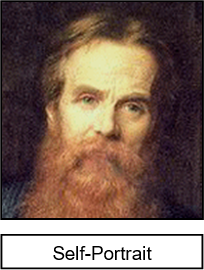 xxxxxHolman Hunt (1827-1910) was the most conscientious of the founder members of the Pre-Raphaelite Brotherhood. A serious-minded man, he kept strictly to the ideals of the movement throughout his career. Indeed, such was his obsession with detail that in 1854 he visited the Middle East in order to provide his chosen subject, The Scapegoat, with a totally authentic setting beside the Dead Sea.
xxxxxHolman Hunt (1827-1910) was the most conscientious of the founder members of the Pre-Raphaelite Brotherhood. A serious-minded man, he kept strictly to the ideals of the movement throughout his career. Indeed, such was his obsession with detail that in 1854 he visited the Middle East in order to provide his chosen subject, The Scapegoat, with a totally authentic setting beside the Dead Sea.
xxxxxToday, however, Hunt is remembered almost exclusively for his picture of Christ in his famous The Light of the World, (illustrated below), a work which brought him instant fame when produced in 1853. This beautiful painting became and has remained a moving symbol of faith throughout the Christian world. Like his other works, such as his The Awakening Conscience of 1853, it was full of religious and moral symbolism. The weeds, for example, represented the sin of daily neglect; the bat signified human ignorance; and Christ’s lantern provided the light of truth, echoing the words in the Psalms: “Thy word is the lamp unto my feet, and a light unto my path”. And worthy of special mention for what he called his “symbolic realism” was his The Shadow of Death, painted in 1873 and illustrated below. Here Jesus is shown in his father’s carpentry shop, his outstretched arms casting a shadow of the Crucifixion on the wall behind him.
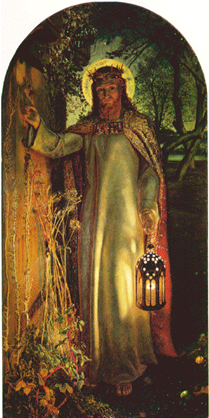 xxxxxHunt was born in Cheapside, London, the son of a warehouse manager, and left school at the age of 12. Determined to become an artist, he left his job as a clerk and in 1843 joined the Royal Academy school. It was here that he met his fellow students Rossetti and Millais and, with them, formed the Pre-Raphaelite Brotherhood. For a time, he shared a studio with Rossetti, but it was Millais who became his life-long friend. We are told that when Hunt went out to the Middle East in 1854, the first of several visits, Millais was deeply upset.
xxxxxHunt was born in Cheapside, London, the son of a warehouse manager, and left school at the age of 12. Determined to become an artist, he left his job as a clerk and in 1843 joined the Royal Academy school. It was here that he met his fellow students Rossetti and Millais and, with them, formed the Pre-Raphaelite Brotherhood. For a time, he shared a studio with Rossetti, but it was Millais who became his life-long friend. We are told that when Hunt went out to the Middle East in 1854, the first of several visits, Millais was deeply upset.
xxxxxHunt’s early pictures - many based on events from literature - included The Eve of St. Agnes in 1848 (based on Keat’s poem of that name), and Valentine and Sylvia and Claudio and Isabella in the early 1850s. And to this same period belong a number of scenes from contemporary life, such as The Hireling Shepherd (illustrated below) and Strayed Sheep, part of a series of pictures he produced under the title Our English Coasts. His two year stay in Palestine and Syria, starting in 1854, produced works from ancient myths and legends as well as religious sources, but they were full of elaborate symbolism and met with only moderate success. Notable among his successful works in later years were The Finding of Our Saviour in the Temple, The Triumph of the Innocents, The Miracle of the Sacred Fire, and the much acclaimed The Lady of Shalott (illustrated below).

xxxxxLike Rossetti, Hunt lacked Millais’ innate ability, but he excelled in the use of natural light, was a stickler for detail, and, as a totally committed artist, he spent long hours perfecting each of his paintings in order to uphold the ideals of the Brotherhood. In 1905 he produced his book Pre-Raphaelitism and the Pre-Raphaelite Brotherhood, a history in which he held that his own contribution to the movement had not been adequately recognised. This might well be the case.
xxxxxIncidentally, the figure of Christ in The Light the World was modelled on two women, Christina Rossetti and her sister in law Elizabeth Siddal, Rossetti’s wife. ……
xxxxx…… The Awakening Conscience can be seen in the Tate Gallery, London, and The Finding of Our Saviour in the Temple in Birmingham City Art Gallery. The Light of the World is in Keble College, Oxford, and a later, larger copy was given to St. Paul’s Cathedral. ……
xxxxx...… Hunt was originally named William Hobman Hunt. He disliked the middle name intensely, and when a spelling error was made on his wedding certificate in 1865, he happily adopted the mistake and from then on became known as “Holman” Hunt.
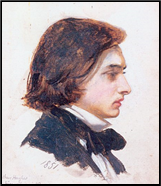
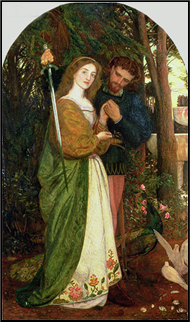 xxxxxWellxworthy of mention at this time is the English artist Arthur Hughes (1832-1915). A member of the Pre-Raphaelite movement, he excelled in painting scenes of contemporary life, such as April Love, The Long Engagement, The Woodman’s Child, Home from Work and Home from the Sea, all produced in the late 1850s and early 1860s. Among his scenes from literature are Ophelia of 1852, The Tryst of 1860, and The Guarded Bower, completed in 1866 (here illustrated). Many of his works are sentimental in tone, and some are tinged with a feeling of regret, but all capture the Pre-Raphaelite style in their superb colouring and close regard to detail. He was also a successful book illustrator, and provided illustrations for Thomas Hughes’ Tom Brown’s Schooldays and Christina Rossetti’s poems for children.
xxxxxWellxworthy of mention at this time is the English artist Arthur Hughes (1832-1915). A member of the Pre-Raphaelite movement, he excelled in painting scenes of contemporary life, such as April Love, The Long Engagement, The Woodman’s Child, Home from Work and Home from the Sea, all produced in the late 1850s and early 1860s. Among his scenes from literature are Ophelia of 1852, The Tryst of 1860, and The Guarded Bower, completed in 1866 (here illustrated). Many of his works are sentimental in tone, and some are tinged with a feeling of regret, but all capture the Pre-Raphaelite style in their superb colouring and close regard to detail. He was also a successful book illustrator, and provided illustrations for Thomas Hughes’ Tom Brown’s Schooldays and Christina Rossetti’s poems for children.






 xxxxxThe Pre-
xxxxxThe Pre- xxxxxBut the end of the Pre-
xxxxxBut the end of the Pre-
 xxxxxThe English painter and poet Dante Gabriel Rossetti (1828-
xxxxxThe English painter and poet Dante Gabriel Rossetti (1828- xxxxxHowever, once the meaning of the initials PRB had become general knowledge, the storm of criticism these works aroused upset and angered the young Rossetti. He continued to produce works in the same vein, but refused to exhibit them in public. These included The First Anniversary of the Death of Beatrice in 1853 and The Preparation for the Passover in the Holy Family of 1856 -
xxxxxHowever, once the meaning of the initials PRB had become general knowledge, the storm of criticism these works aroused upset and angered the young Rossetti. He continued to produce works in the same vein, but refused to exhibit them in public. These included The First Anniversary of the Death of Beatrice in 1853 and The Preparation for the Passover in the Holy Family of 1856 -

 xxxxxAs a founder member of the Pre-
xxxxxAs a founder member of the Pre-
 xxxxxBy then, however, Millais had brought about the virtual collapse of the brotherhood. A child of precocious artistic talent, and a star at the Royal Academy at the age of eleven, he began to see his future in commercial terms. In 1853 his The Order of Release, a highly romantic painting showing the release of a Jacobite rebel after the Battle of Culloden in 1746, proved extremely popular and earned him election as an Associate of the Royal Academy. (As far as Rossetti was concerned, this was joining the enemy and meant an end to the society). And the enormous success Millet achieved with his The Black Brunswicker of 1860, showing a soldier leaving his beloved on the eve of the Battle of Waterloo (illustrated right), convinced him that his future lay in pandering to the Victorian taste for the patriotic, the romantic, and the melodramatic. By the mid-
xxxxxBy then, however, Millais had brought about the virtual collapse of the brotherhood. A child of precocious artistic talent, and a star at the Royal Academy at the age of eleven, he began to see his future in commercial terms. In 1853 his The Order of Release, a highly romantic painting showing the release of a Jacobite rebel after the Battle of Culloden in 1746, proved extremely popular and earned him election as an Associate of the Royal Academy. (As far as Rossetti was concerned, this was joining the enemy and meant an end to the society). And the enormous success Millet achieved with his The Black Brunswicker of 1860, showing a soldier leaving his beloved on the eve of the Battle of Waterloo (illustrated right), convinced him that his future lay in pandering to the Victorian taste for the patriotic, the romantic, and the melodramatic. By the mid- xxxxxIt was a change of direction that was to make Millet one of the most popular and richest artists of his day. Over the next thirty years he produced a steady stream of pot-
xxxxxIt was a change of direction that was to make Millet one of the most popular and richest artists of his day. Over the next thirty years he produced a steady stream of pot- xxxxxFollowing the annulment, Millais and Effie were married in 1855, and the first of their eight children was born the following year. But throughout their married life Effie was shunned by many members of society. Queen Victoria, who openly admired Millet’s work, was shocked by what she saw as a sordid affair, and refused to receive Effie. It was not until Millet lay on his death bed that she granted his dying wish and met Effie privately at Windsor Castle. Effie herself died in December the following year. (Detail of portrait by the English artist Thomas Richmond.)
xxxxxFollowing the annulment, Millais and Effie were married in 1855, and the first of their eight children was born the following year. But throughout their married life Effie was shunned by many members of society. Queen Victoria, who openly admired Millet’s work, was shocked by what she saw as a sordid affair, and refused to receive Effie. It was not until Millet lay on his death bed that she granted his dying wish and met Effie privately at Windsor Castle. Effie herself died in December the following year. (Detail of portrait by the English artist Thomas Richmond.) xxxxxHolman Hunt (1827-
xxxxxHolman Hunt (1827- xxxxxHunt was born in Cheapside, London, the son of a warehouse manager, and left school at the age of 12. Determined to become an artist, he left his job as a clerk and in 1843 joined the Royal Academy school. It was here that he met his fellow students Rossetti and Millais and, with them, formed the Pre-
xxxxxHunt was born in Cheapside, London, the son of a warehouse manager, and left school at the age of 12. Determined to become an artist, he left his job as a clerk and in 1843 joined the Royal Academy school. It was here that he met his fellow students Rossetti and Millais and, with them, formed the Pre-

 xxxxxWellxworthy of mention at this time is the English artist Arthur Hughes (1832-
xxxxxWellxworthy of mention at this time is the English artist Arthur Hughes (1832-

